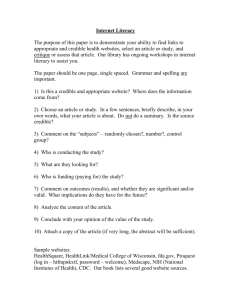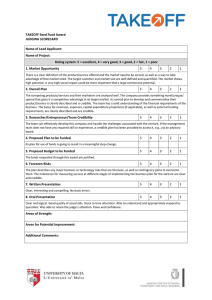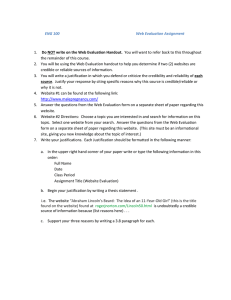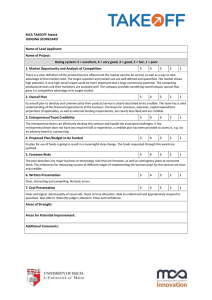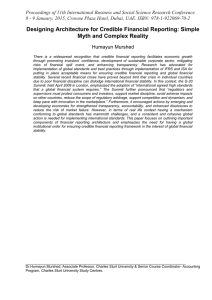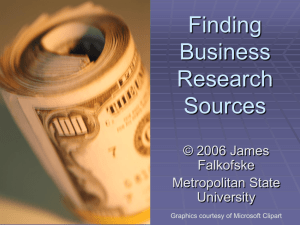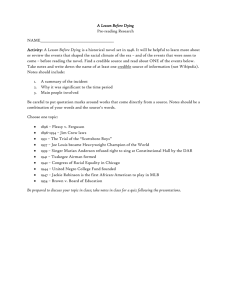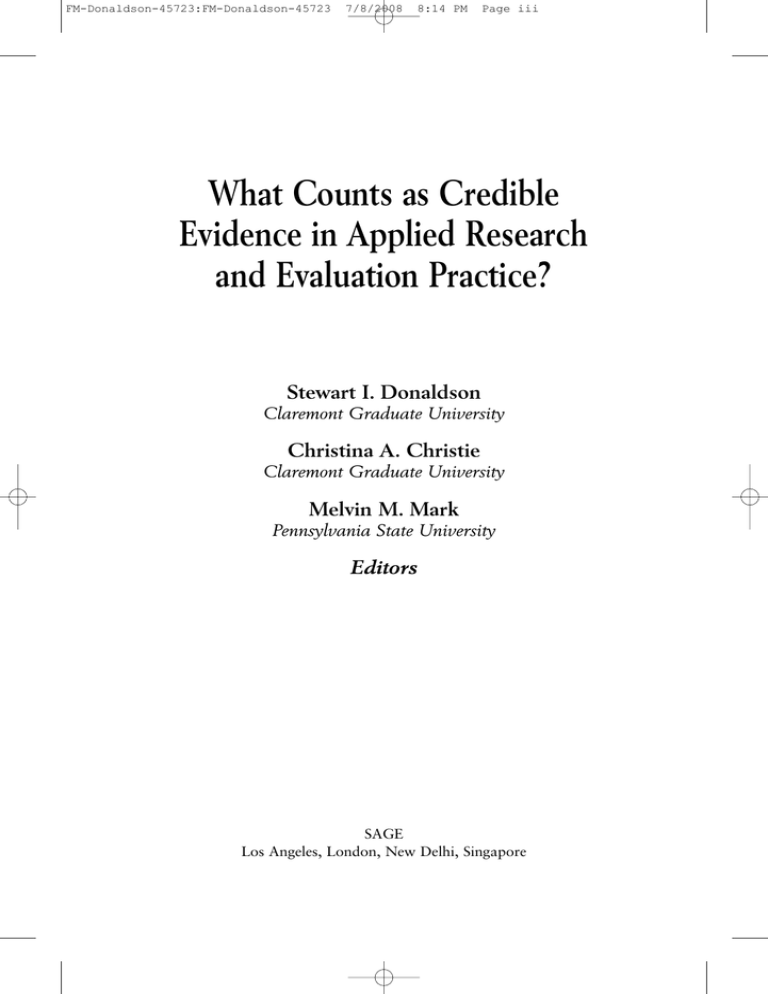
FM-Donaldson-45723:FM-Donaldson-45723
7/8/2008
8:14 PM
Page iii
What Counts as Credible
Evidence in Applied Research
and Evaluation Practice?
Stewart I. Donaldson
Claremont Graduate University
Christina A. Christie
Claremont Graduate University
Melvin M. Mark
Pennsylvania State University
Editors
SAGE
Los Angeles, London, New Delhi, Singapore
FM-Donaldson-45723:FM-Donaldson-45723
7/8/2008
8:14 PM
Page iv
Copyright © 2009 by Sage Publications, Inc.
All rights reserved. No part of this book may be reproduced or utilized in any form
or by any means, electronic or mechanical, including photocopying, recording, or by
any information storage and retrieval system, without permission in writing from
the publisher.
For information:
SAGE Publications, Inc.
2455 Teller Road
Thousand Oaks,
California 91320
E-mail: order@sagepub.com
SAGE Publications India Pvt. Ltd.
B 1/I 1 Mohan Cooperative
Industrial Area
Mathura Road, New Delhi 110 044
India
SAGE Publications Ltd.
1 Oliver’s Yard
55 City Road
London EC1Y 1SP
United Kingdom
SAGE Publications
Asia-Pacific Pte. Ltd.
33 Pekin Street #02-01
Far East Square
Singapore 048763
Printed in the United States of America
Library of Congress Cataloging-in-Publication Data
What counts as credible evidence in applied research and evaluation practice? /
Stewart I. Donaldson, Christina A. Christie, [and] Melvin M. Mark, editors.
p. cm.
Includes bibliographical references and index.
ISBN 978-1-4129-5707-6 (pbk.: acid-free paper)
1. Research—Evaluation. 2. Research—Social aspects. 3. Social sciences—
Methodology. 4. Evaluation research (Social action programs) 5. Educational
accountability. I. Donaldson, Stewart I. (Stewart Ian) II. Christie, Christina A.
III. Mark, Melvin M.
Q180.55.E9W53 2009
001.4′2—dc22
2008017667
This book is printed on acid-free paper.
08
09
10
11
12
Acquisitions Editor:
Editorial Assistant:
Production Editor:
Copy Editor:
Typesetter:
Proofreader:
Indexer:
Cover Designer:
Marketing Manager:
10
9
8
7
6
5
Vicki Knight
Lauren Habib
Catherine M. Chilton
Teresa Herlinger
C&M Digitals (P) Ltd.
Candice Harman
Stephanie Adams
4
3
2
1
Epilogue-Donaldson-45723:Epilogue-Donaldson-45723
7/8/2008
7:13 PM
Page 239
Epilogue
A Practitioner’s Guide for
Gathering Credible Evidence
in the Evidence-Based Global Society
Stewart I. Donaldson
W
hat do the discussions and debates about credible evidence offer
practitioners? I will attempt to answer this question for you by
briefly providing some observations about the diversity and changing nature
of the enterprise, by offering some lessons from my own applied research
and evaluation practice, and by discussing how practitioners might address
some of the key issues and challenges of collecting credible evidence raised
throughout the chapters in this volume.
Understanding Practice Today
In Chapter 1, I discussed indicators that suggest the demand for credible
evidence is at an all-time high across the globe, and that applied research and
evaluation practice is booming. The recent surge of activity has expanded
well beyond the evaluation of traditional, large-scale, government programs.
Evaluation and applied research are being conducted on a much wider range
of problems, programs, policies, practices, products, personnel, organizations, proposals, and the like across a diverse range of community, organizational, government, and global settings. Practitioners today are confronted
with a shifting landscape of applied research and evaluation practice.
239
Epilogue-Donaldson-45723:Epilogue-Donaldson-45723
7/8/2008
7:13 PM
Page 240
240——What Counts as Credible Evidence?
I have suggested that this changing landscape has set the stage for a
similar but broader perspective on evidence than D. T. Campbell’s (1991)
earlier vision of an “experimenting society.” This new vision of an
“evidence-based global society” promotes the search for and thoughtful
reflection about evidence collected from a wide range of designs and methods to answer key applied research and evaluation questions. While the gold
standard in the evidence-based society might be thought of as “methodological appropriateness” (Mark, Chapter 12; Schwandt, Chapter 11), it is
important to underscore that RCTs will play a very important role and will
be considered the gold standard for answering some questions under specific
circumstances, as will other research and evaluation approaches, designs,
and methods when the conditions are optimal for their use.
It is most likely a healthy sign for the intellectual development of the field
if the debates rage on about credible evidence, gold standards, and optimal
research and evaluation paradigms and designs. Our hope should be that
these discussions in the scholarly literature, perhaps reframed as Mark suggests (Chapter 12), will inspire research and inquiries that someday provide
practitioners with more evidence-based guidance about how best to practice
applied research and evaluation. But in the meantime, there is critically
important work to be done and this natural uncertainty in a young field
should not slow us down in our pursuit to help solve the important problems of the day. As we practice applied research and evaluation, let me suggest that we as practitioners draw on the body of knowledge about practice
we have now accumulated. Below, I briefly review the value of our knowledge base with respect to evaluation theory, design and methods, the profession, and research on evaluation.
Evaluation Theory
Practitioners working in the new “evidence-based global society” can
benefit greatly from understanding how to use theory to enhance their practice. Donaldson and Lipsey (2006) have spelled out in some detail the different roles that different types of theory can play to improve contemporary
applied research and evaluation practice. One of these theory forms is evaluation theory, which is largely prescriptive theory that “offers a set of rules,
prescriptions, prohibitions, and guiding frameworks that specify what a
good or proper evaluation is and how evaluation should be done” (Alkin,
2004). Evaluation theories are thus theories of evaluation practice that
address such enduring themes as how to understand the nature of what we
evaluate, how to assign value to programs and their performance, how to
construct knowledge, and how to use the knowledge generated by evaluation
Epilogue-Donaldson-45723:Epilogue-Donaldson-45723
7/8/2008
7:13 PM
Page 241
Epilogue——241
(e.g., Alkin, 2004; Donaldson & Scriven, 2003; Shadish, Cook, & Leviton,
1991).
In 1997, the president of the American Evaluation Association, William
Shadish, emphasized the vast importance of teaching practitioners how to
benefit from and use evaluation theory to improve practice. His presidential
address was entitled “Evaluation Theory Is Who We Are,” and emphasized
the following:
All evaluators should know evaluation theory because it is central to our professional identity. It is what we talk about more than anything else, it seems to
give rise to our most trenchant debates, it gives us the language we use for talking to ourselves and others, and perhaps most important, it is what makes us
different from other professions. Especially in the latter regards, it is in our
own self-interest to be explicit about this message, and to make evaluation theory the very core of our identity. Every profession needs a unique knowledge
base. For us, evaluation theory is that knowledge base. (Shadish, 1998, p. 1)
Evaluation theories can also help us understand our quest as practitioners to gather credible evidence. They often take a stand on what counts as
credible evidence in practice. However, evaluation theories today are rather
diverse and some are at odds with one another (see Donaldson & Scriven,
2003). Understanding these differences between theories of practice can help
us understand disagreements about what counts as credible evidence.
In professional practice, it is vitally important that we are clear about our
assumptions and purposes for conducting applied research and evaluation.
Evaluation theory can help us make those decisions, and help us understand
why other applied researchers and evaluators might make different decisions
in practice, or criticize the decisions we have made about gathering credible
evidence. In summary, being well-versed in contemporary theories of evaluation practice can enhance our ability to make sound choices about gathering evidence to answer the key applied research and evaluation questions
we are being paid to address.
Design and Methods
The decisions made in practice about research and evaluation design and
methods can often be traced back to evaluation theory, or at least a practitioner’s assumptions and views about what constitutes good evaluation
practice. Christie and Fleischer (Chapter 2) discussed how assumptions
about social inquiry and scientific paradigms seem to color views about
which designs and methods provide the most credible evidence. What should
be clear from the chapters in this volume is that contemporary practitioners
Epilogue-Donaldson-45723:Epilogue-Donaldson-45723
7/8/2008
7:13 PM
Page 242
242——What Counts as Credible Evidence?
now have a wide range of designs and methods to choose from when they
are charged to gather credible evidence. The discussions throughout the previous chapters take us to a new level of understanding about the strengths
and limitations of these various designs and methods. I will discuss in more
detail later the ways that a practitioner can use this knowledge to make
decisions about which designs and methods to employ in practice.
The Profession
The profession of applied research and evaluation is maturing. As was
discussed in Chapter 1, more practitioners than ever before are participating
in annual professional meetings, going to professional development activities, and collaborating with one another in an effort to learn about best practices. The number of professional associations has grown dramatically
throughout the world in the past 15 years, and the size of the more established associations has increased substantially. These organizations now
offer us as practitioners a wide range of resources for improving our practice such as the latest books and journals, regular convenings, a range of
professional development opportunities, guiding principles, and evaluation
standards. Donaldson and Christie (2006) describe the emerging transdiscipline and profession in some detail, and provide examples of the broad array
of career opportunities that now exist in applied research and evaluation.
The resources now available from the profession can greatly enhance a practitioner’s ability to gather credible evidence and to provide accurate and
useful applied research and evaluations.
Research on Evaluation
Theories of evaluation practice tend to be based more on philosophy and
experience than on systematic evidence of their effectiveness. That is, unlike
social science theories used to help program and policy design, evaluation
theories remain largely prescriptive and unverified. There has been a recent
surge of interest in developing an evidence base to complement theory for
guiding how best to practice applied research and evaluation (Donaldson,
2007; Henry & Mark, 2003; Mark, 2003, 2007).
Although research on evaluation is an emerging area and a limited source
of help for practitioners at the present time, there are now important works
we can point to as exemplars for how research can improve the way we practice in the future. For example, there is a long tradition of research illuminating how to conduct evaluations so they are useful and have influence
(Cousins, 2007). Other recent studies examine the links between evaluation
Epilogue-Donaldson-45723:Epilogue-Donaldson-45723
7/8/2008
7:13 PM
Page 243
Epilogue——243
theory and practice (Alkin & Christie, 2005; Christie, 2003; Fitzpatrick,
2004), the development of evaluation practice competencies (Ghere, King,
Stevahn, & Minnema, 2006), strategies for managing evaluation anxiety
(Donaldson, Gooler, & Scriven, 2002), improving the relationships between
evaluators and stakeholders (Donaldson, 2001; B. Campbell & Mark,
2006), and the like. Along these same lines, Schwandt (Chapter 11, this volume) proposes an agenda of inquiry that might lead to the development of a
practical theory of how to gather credible evidence in applied research and
evaluation. Furthermore, the American Evaluation Association has recently
supported the development of a new Topic Interest Group charged with
expanding the evidence base for practice by promoting much more research
on evaluation., All of these examples underscore the point that research on
evaluation holds great promise for advancing our understanding of how best
to practice in contemporary times in general, and more specifically how best
to gather credible evidence.
Program Theory–Driven Evaluation Science
I have recently provided a framework and detailed examples of how to
gather credible evidence in contemporary, practical program evaluations
(Donaldson, 2007). This framework attempts to incorporate many of the
hard-won lessons in applied research and evaluation practice over the past
30 years, and to provide an evolving, integrative, and contingency-based theory of practice. Program theory–driven evaluation science offers practitioners the following concise, three-step approach to practice:
1. Developing program impact theory
2. Formulating and prioritizing evaluation questions
3. Answering evaluation questions
Simply stated, evaluators work with stakeholders to develop a common
understanding of how a program is presumed to solve the problem(s) of
interest; to formulate and prioritize key evaluation questions; and then to
decide how best to gather credible evidence to answer those questions within
practical, time, and resource constraints.
This practical program evaluation approach is essentially method neutral
within the broad domain of social science methodology. The focus on the
development of program theory and evaluation questions frees evaluators
initially from having to presuppose use of one evaluation design or another.
Epilogue-Donaldson-45723:Epilogue-Donaldson-45723
7/8/2008
7:13 PM
Page 244
244——What Counts as Credible Evidence?
The choice of the evaluation design and methods used to gather credible
evidence is made in collaboration with the relevant stakeholders, and is not
solely decided by the evaluation team. The decisions about how best to go
about collecting credible evidence to answer the key evaluation questions are
typically thought to be contingent on the nature of the questions to be
answered and the context of the setting. Stakeholders are provided with a
wide range of choices for gathering credible evidence, which reinforces the
idea that neither quantitative, qualitative, nor mixed method designs are
necessarily superior or applicable in every applied research and evaluation
context (e.g., Chen, 1997). Whether an evaluator uses case studies, observational methods, structured or unstructured interviews, online or telephone
survey research, a quasi-experiment, or an RCT to answer the key evaluation questions is dependent on discussions with relevant stakeholders about
what would constitute credible evidence in this context, and what is feasible
given the practical, time, and financial constraints (Donaldson, 2007;
Donaldson & Lipsey, 2006).
This practical approach for gathering credible evidence is highly consistent with the profession’s guiding principles, evaluation standards, and other
mainstream approaches to practical program evaluation (Chen, 2005; Rossi,
Lipsey, & Freeman, 2004; Weiss, 1998). One of the best examples to date
of program theory–driven evaluation science in action is embodied in the
Centers for Disease Control’s (1999) six-step Program Evaluation
Framework. This framework is not only conceptually well developed and
instructive for evaluation practitioners, it also has been widely adopted for
evaluating federally funded public health programs throughout the United
States. One of the six key steps in this framework is Step 4: Gather Credible
Evidence. Step 4 is defined in the following way:
Compiling information that stakeholders perceive as trustworthy and relevant
for answering their questions. Such evidence can be experimental or observational, qualitative or quantitative, or it can include a mixture of methods.
Adequate data might be available and easily accessed, or it might need to be
defined and new data collected. Whether a body of evidence is credible to
stakeholders might depend on such factors as how the questions were posed,
sources of information, conditions of data collection, reliability of measurement, validity of interpretations, and quality control procedures.
Program theory–driven evaluation science is just one of many forms of
evaluation theory available today to help guide evaluation practice (see
Donaldson & Scriven, 2003). It is summarized here to illustrate how evaluation theories do offer guidance in terms of how to gather credible evidence
in contemporary practice. This particular perspective remains open to the
Epilogue-Donaldson-45723:Epilogue-Donaldson-45723
7/8/2008
7:13 PM
Page 245
Epilogue——245
wide range of experimental and nonexperimental views about what counts
as credible evidence that have been expressed throughout this volume.
However, it clearly specifies that there is not a universal answer to the
question of what counts as credible evidence. Rather, the answer to this
question in any particular evaluation context is contingent on the evaluation
questions, and choices made by the relevant stakeholders in the light of practical, time, and resource constraints.
Some Final Thoughts About
the Debates on Credible Evidence
The chapter authors in Section II presented us with some very compelling
arguments about the strengths of RCTs and experimental approaches as the
route to credible evidence, particularly when the stakes are high for determining “what works.” It is laudable that these chapters also explored the
limitations and boundary conditions of the experimental approach to gathering credible evidence. The chapters in Section III do an excellent job of
extending our understanding of the limitations of the experimental
approach, and highlighting the problems of considering the RCT as a universal gold standard for gathering credible evidence. These chapters also
provide us with a much deeper understanding of the increasing range of nonexperimental approaches to gathering credible evidence, and the broad array
of evaluation questions that can be answered in applied research and evaluation, moving us way beyond the common question of “what works.”
However, as Mark points out in Chapter 12, it should be underscored
that the chapters in this volume demonstrate that the topic of “what counts
as credible evidence” is not one where consensus exists at this time in our
history. In fact, while the volume has been in production there has been a
plethora of new disputes and debates about credible evidence across the
emerging evidence-based global society. For example, the European
Evaluation Society (EES, 2007) recently issued a statement in response to
strong pressure from some interests advocating for “scientific” and “rigorous” impact of development aid, where this is defined as primarily involving
RCTs: “EES deplores one perspective currently being strongly advocated:
that the best or only rigorous and scientific way of doing so is through randomised controlled trials (RCTs). In contrast, the EES supports multimethod approaches to IE and does not consider any single method such as
RCTs as first choice or as the ‘gold standard’.” This new statement briefly
discusses the rationale for this perspective, and lists examples of publications
that consider a number of alternative approaches for establishing impact.
Epilogue-Donaldson-45723:Epilogue-Donaldson-45723
7/8/2008
7:14 PM
Page 246
246——What Counts as Credible Evidence?
Please note the similarities of the debate now going on in Europe and other
parts of the world, with the North American version as expressed in the AEA
Statement and Not AEA Statement displayed in Chapter 1.
EES Statement: The importance of a methodologically diverse approach to
impact evaluation—specifically with respect to development aid and development interventions.
December 2007
The European Evaluation Society (EES), consistent with its mission to promote the “theory, practice and utilization of high quality evaluation,” notes
the current interest in improving impact evaluation and assessment (IE) with
respect to development and development aid. EES however deplores one perspective currently being strongly advocated: that the best or only rigorous and
scientific way of doing so is through randomised controlled trials (RCTs).
In contrast, the EES supports multi-method approaches to IE and does not
consider any single method such as RCTs as first choice or as the “gold standard”:
• The literature clearly documents how all methods and approaches have
strengths and limitations and that there are a wide range of scientific,
evidence-based, rigorous approaches to evaluation that have been used
in varying contexts for assessing impact.
• IE is complex, particularly of multi-dimensional interventions such as
many forms of development (e.g., capacity building, Global Budget
Support, sectoral development) and consequently requires the use of a
variety of different methods that can take into account rather than
dismiss this inherent complexity.
• Evaluation standards and principles from across Europe and other parts
of the world do not favor a specific approach or group of approaches—
although they may require that the evaluator give reasons for selecting
a particular evaluation design or combination.
RCTs represent one possible approach for establishing impact, that may be
suitable in some situations, e.g.:
• With simple interventions where a linear relationship can be established
between the intervention and an expected outcome that can be clearly
defined;
• Where it is possible and where it makes sense to “control” for context and
other intervening factors (e.g., where contexts are sufficiently comparable);
• When it can be anticipated that programmes under both experimental
and control conditions can be expected to remain static (e.g., not
attempt to make changes or improvements), often for a considerable
period of time;
Epilogue-Donaldson-45723:Epilogue-Donaldson-45723
7/8/2008
7:14 PM
Page 247
Epilogue——247
• Where it is possible and ethically appropriate to engage in randomization
and to ensure the integrity of the differences between the experimental
and control conditions.
Even in these circumstances, it would be “good practice” not to rely on one
method but rather combine RCTs with other methods—and to triangulate the
results obtained.
As with any other method, an RCT approach also has considerable limitations that may limit its applicability and ability to contribute to policy, e.g.:
• RCT designs are acknowledged even by many of its proponents to be
weak in external validity (or generalisability), as well as in identifying the
actual mechanisms that may be responsible for differences in outcomes
between the experimental and control situations;
• “Scaling up,” across-the-board implementation based upon the results of
a limited and closely controlled pilot situation, can be appropriate
for those interventions (e.g., drug trials) where the conditions of
implementation would be the same as in the trial, but this is rarely the
case for most socio-economic interventions where policy or program
“fidelity” cannot be taken for granted;
• An RCT approach is rarely appropriate in complex situations where an
outcome arises from interaction of multiple factors and interventions,
and where it makes little sense to “control” for these other factors. In a
development context, as for most complex policy interventions, outcomes
are the result of multiple factors interacting simultaneously, rather than
of a single “cause”;
• RCTs are limited in their ability to deal with emergent and/or unintended
and unanticipated outcomes as is increasingly recognized in complexity
and systems research—many positive benefits of development interventions
will often be related rather than identical to those anticipated at the
policy/program design stage;
• RCTs generally are less suited than other approaches in identifying what
works for whom and under what circumstances. Identifying what
mechanisms lead to an identified change is particularly important given
the varying contexts under which development typically takes place and
is essential for making evidence-based improvements.
We also note that RCTs are based upon a successionist (sometimes referred
to as “factual”) model of causality that neglects the links between intervention
and impact and ignores other well-understood scientific means of establishing
causality, e.g.:
(Continued)
Epilogue-Donaldson-45723:Epilogue-Donaldson-45723
7/8/2008
7:14 PM
Page 248
248——What Counts as Credible Evidence?
(Continued)
• Both the natural and social sciences (e.g., physics, astronomy, economics)
recognize other forms of causality, such as generative (sometimes
referred to as “physical”) causality that involve identifying the underlying
processes that lead to a change. An important variant of generative
causality is known as the modus operandi that involves tracing the
“signature,” where one can trace an observable chain of events that links
to the impact.
• Other forms of causality recognize simultaneous and/or alternative
causal strands, e.g., acknowledging that some factors may be necessary
but not sufficient to bring about a given result, or that an intervention
could work through one or more causal paths. In non-linear relationships,
sometimes a small additional effort can serve as a “tipping point” and
have a disproportionately large effect.
• Some research literature questions whether simple “causality” (vs.
“contribution” or “reasonable attribution”) is always the right approach,
given the complexity of factors that necessarily interact in contemporary
policy—many of them in specific contexts.
EES also notes that in the context of the Paris Declaration, it is appropriate
for the international evaluation community to work together in supporting the
enhancement of development partner capacity to undertake IE. Mandating a
specific approach could undermine the spirit of the Paris Declaration and as
the literature on evaluation utilization has demonstrated, limit buy-in and
support for evaluation and for subsequent action.
In conclusion, EES welcomes the increased attention and funding for
improving IE, provided that this takes a multi-method approach drawing from
the rich diversity of existing frameworks and one that engages both the developed and developing world. We would be pleased to join with others in participating in this endeavour. (European Evaluation Society, 2007)
Conclusion: So What Counts as Credible Evidence?
It depends! The chapters in this volume have shown us that the answer to
this question depends on characteristics such as
• The question(s) of interest
• The context
• Assumptions made by the evaluators and stakeholders
Epilogue-Donaldson-45723:Epilogue-Donaldson-45723
7/8/2008
7:14 PM
Page 249
Epilogue——249
• The evaluation theory used to guide practice
• Practical, time, and resource constraints
Let these subtle nuances help you answer that question clearly in the context of your own evaluation practice.
Stated another way, I think it is safe to say we are a long way from consensus and a universal answer to the question of what counts as credible evidence in contemporary applied research and evaluation. However, the very
rich discussions throughout this volume and the debates across the globe are
providing us with ideas for what might go into an early draft of a blueprint
for the emerging “evidence-based global society.” It now seems clear that
disparate views about what constitutes credible evidence are predicated
on divergent assumptions, often implicit (Mark, Chapter 12). Practitioners
should be well advised to explore these assumptions in great depth with their
stakeholders before embarking on their quest to gather credible evidence. A
full exploration of the strengths and weaknesses for the range of designs and
methods available for any given applied research and evaluation problem
seems warranted. A goal to strive for is to fully inform the key stakeholders
of the benefits and costs of the wide range of approaches available to answer
their key applied research and evaluation questions before they embark with
you on the journey of gathering credible evidence (Donaldson, 2007).
A potential unintended positive consequence of disagreements about how
to best gather evidence is the interest being sparked to support more serious
research and scholarship focused on advancing the understanding of how
best to practice applied research and evaluation. Practitioners now have a
wealth of resources to help guide their practice such as evaluation theory, a
range of professional development opportunities, many more design and
method options, and the promise of “research on evaluation” sorting out
some of the more intractable problems preventing good practice. This volume has offered you a plethora of ideas and new directions to explore as you
continue your pursuits of gathering credible evidence. It is my hope that this
volume will inspire you to be much more reflective about your practice and
the range of designs and methods that might be feasible to help you answer
the pressing applied research and evaluation questions you encounter. In the
end, great minds may disagree that there is a best road to travel to get to
credible evidence, but they do seem to come together in consensus around
the view that applied research and evaluation are critical activities for
improving societies and the human condition as we venture into the
unknowns of the 21st-century evidence-based global society.
Epilogue-Donaldson-45723:Epilogue-Donaldson-45723
7/8/2008
7:14 PM
Page 250
250——What Counts as Credible Evidence?
References
Alkin, M. C. (Ed.). (2004). Evaluation roots: Tracing theorists’ views and influences.
Thousand Oaks, CA: Sage Publications.
Alkin, M. C., & Christie, C. A. (2005). Theorists’ models in action [Entire issue].
New Directions for Evaluation, 106.
Campbell, B., & Mark, M. M. (2006). Toward more effective stakeholder dialogue:
Applying theories of negotiation to policy and program evaluation. Journal of
Applied Social Psychology, 36(12), 2834–2863.
Campbell, D. T. (1991). Methods for the experimenting society. American Journal of
Evaluation, 12(3), 223–260.
Centers for Disease Control and Prevention. (1999). Framework for program evaluation in public health. MMWR, 48 (No. RR-11). CDC Evaluation Working Group.
Chen, H. T. (1997). Applying mixed methods under the framework of theory-driven
evaluations. In J. Greene & V. Caracelli (Eds.), Advances in mixed methods evaluation: The challenge and benefits of integrating diverse paradigms (pp. 61–72).
(Vol. 74 of New Directions for Evaluation series). San Francisco: Jossey-Bass.
Chen, H. T. (2005). Practical program evaluation: Assessing and improving planning,
implementation, and effectiveness. Thousand Oaks, CA: Sage Publications.
Christie, C. A. (2003). What guides evaluation? A study of how evaluation practice
maps onto evaluation theory. In C. A. Christie (Ed.), The practice–theory relationship in evaluation (pp. 1–35). (Vol. 97 of New Directions for Evaluation
series). San Francisco: Jossey-Bass.
Cousins, J. B. (Ed.). (2007). Process use in theory, research, and practice [Entire issue].
New Directions for Evaluation, 116.
Donaldson, S. I. (2001). Overcoming our negative reputation: Evaluation becomes
known as a helping profession. American Journal of Evaluation, 22(3), 355–361.
Donaldson, S. I. (2005). Using program theory–driven evaluation science to crack
the Da Vinci code. In M. Alkin & C. Christie (Eds.), Theorists’ models in action
(pp. 65–84). (Volume 106 of New Directions for Evaluation series). San
Francisco: Jossey-Bass.
Donaldson, S. I. (2007). Program theory–driven evaluation science: Strategies and
applications. Mahwah, NJ: Erlbaum.
Donaldson, S. I., & Christie, C. A. (2006). Emerging career opportunities in the transdiscipline of evaluation science. In S. I. Donaldson, D. E. Berger, & K. Pezdek
(Eds.), Applied psychology: New frontiers and rewarding careers (pp. 243–260).
Mahwah, NJ: Erlbaum.
Donaldson, S. I., Gooler, L. E., & Scriven, M. (2002). Strategies for managing evaluation anxiety: Toward a psychology of program evaluation. American Journal
of Evaluation, 23(3), 261–273.
Donaldson, S. I., & Lipsey, M. W. (2006). Roles for theory in contemporary evaluation practice: Developing practice knowledge. In I. Shaw, J. C. Greene, & M. M.
Mark (Eds.), The handbook of evaluation: Policies, programs, and practices
(pp. 56–75). London: Sage Publications.
Epilogue-Donaldson-45723:Epilogue-Donaldson-45723
7/8/2008
7:14 PM
Page 251
Epilogue——251
Donaldson, S. I., & Scriven, M. (Eds.). (2003). Evaluating social programs and problems: Visions for the new millennium. Mahwah, NJ: Erlbaum.
European Evaluation Society. (2007). EES Statement: The importance of a methodologically diverse approach to impact evaluation—specifically with respect to
development aid and development interventions. Retrieved February 7, 2008,
from http://www.europeanevaluation.org/download/?id=1969403.
Fitzpatrick, J. L. (2004). Exemplars as case studies: Reflections on the links between
theory, practice, and context. American Journal of Evaluation, 25(4), 541–559.
Ghere, G., King, J. A., Stevahn, L., & Minnema, J. (2006). A professional development unit for reflecting on program evaluator competencies. American Journal
of Evaluation, 27(1), 108–123.
Henry, G. T., & Mark, M. M. (2003). Toward an agenda for research on evaluation.
In C. A. Christie (Ed.), The practice–theory relationship in evaluation
(pp. 69–80). (Vol. 97 of New Directions for Evaluation series). San Francisco:
Jossey-Bass.
Mark, M. M. (2003). Toward an integrated view of the theory and practice of program and policy evaluation. In S. I. Donaldson & M. Scriven (Eds.), Evaluating
social programs and problems: Visions for the new millennium (pp. 183–204).
Mahwah, NJ: Erlbaum.
Mark, M. M. (2007). Building a better evidence base for evaluation theory: Beyond
general calls to a framework of types of research on evaluation. In N. L. Smith &
P. R. Brandon (Eds.), Fundamental issues in evaluation (pp. 111–134). New
York: Guilford Press.
Rossi, P. H., Lipsey, M. W., & Freeman, H. E. (2004). Evaluation: A systematic
approach (7th ed.). Thousand Oaks, CA: Sage Publications.
Shadish, W. R. (1998). Evaluation theory is who we are. American Journal of
Evaluation, 19(1), 1–19.
Shadish, W. R., Cook, T. D., & Leviton, L. C. (1991). Foundations of program evaluation: Theories of practice. Newbury Park, CA: Sage Publications.
Weiss, C. H. (1998). Evaluation: Methods for studying programs and policies
(2nd ed.). Upper Saddle River, NJ: Prentice Hall.

